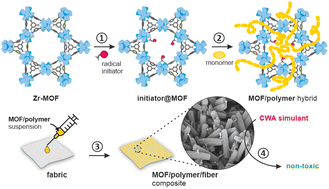MOF/polymer hybrids through in situ free radical polymerization in metal-organic frameworks†
Abstract
We use the free radical polymerization initiator 4,4′-azobis(cyanovaleric acid) coordinated to the open metal sites of metal-organic frameworks (MOFs) to give rise to highly uniform MOF/polymer hybrids. We demonstrate this strategy on two robust zirconium MOFs (NU-1000 and MOF-808), which are the most effective catalysts for degradation of chemical warfare nerve agents. The resulting hybrid materials maintain their hydrolytic catalytic activity and have substantially improved adhesion to polypropylene and activated carbon textile fibers, yielding highly robust MOF/polymer/textile hybrid systems. These composites are suitable for the green production of active protective clothing and filters capable of detoxifying organophosphorus warfare agents.

- This article is part of the themed collections: Materials Horizons Emerging Investigators Series 2022/2023, 2023 Materials Horizons Most Popular Articles and Materials Horizons 10th anniversary regional spotlight collection: Europe


 Please wait while we load your content...
Please wait while we load your content...